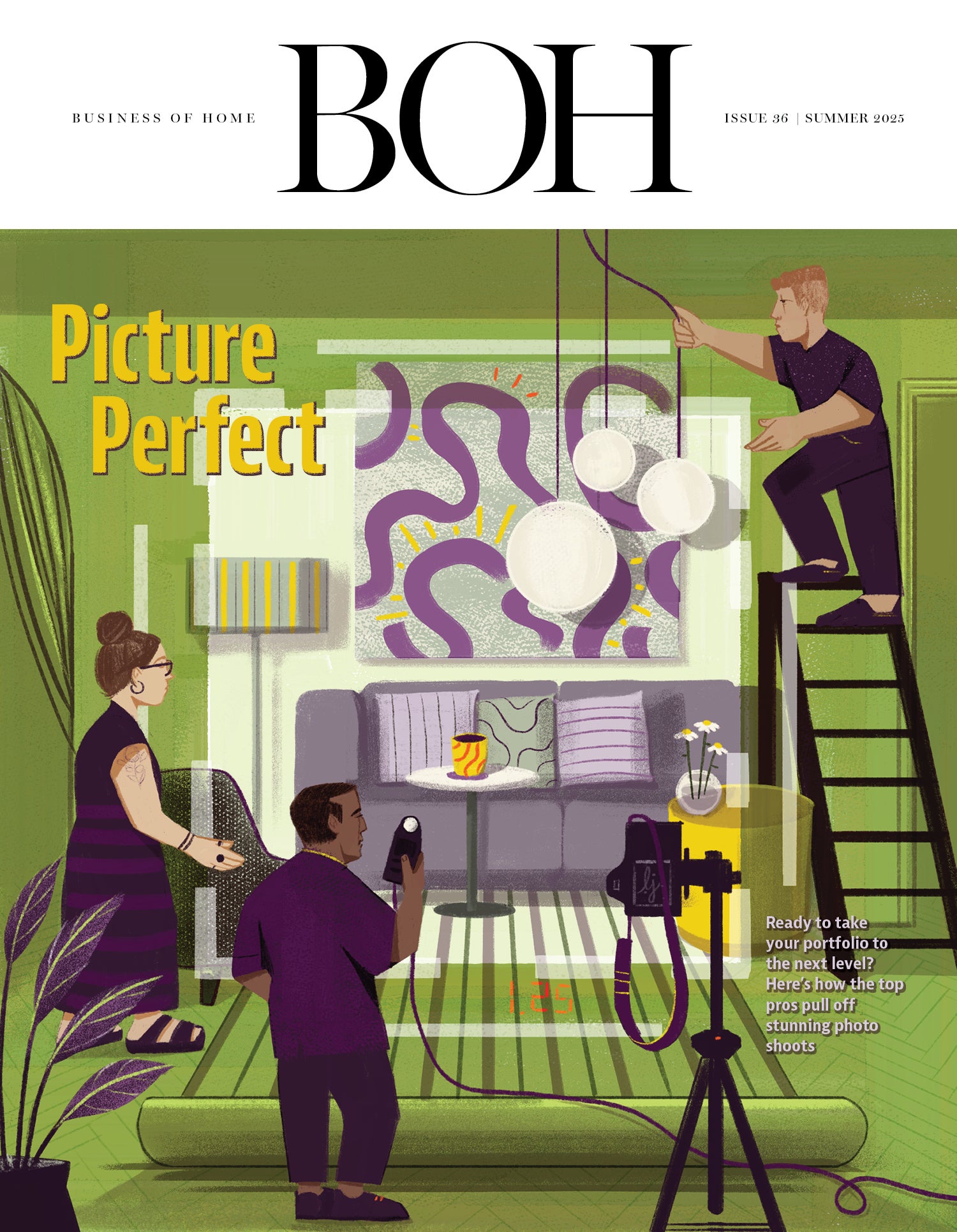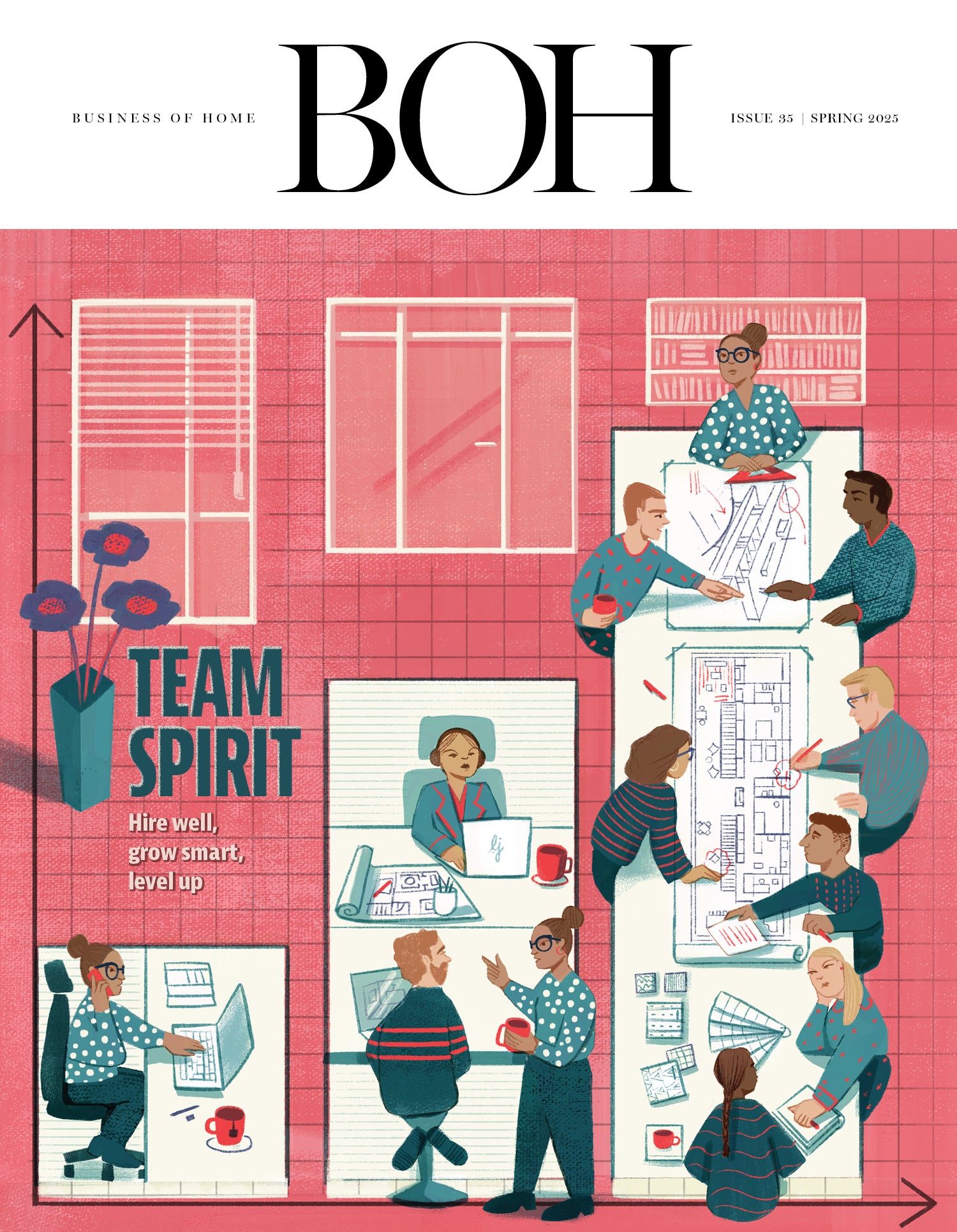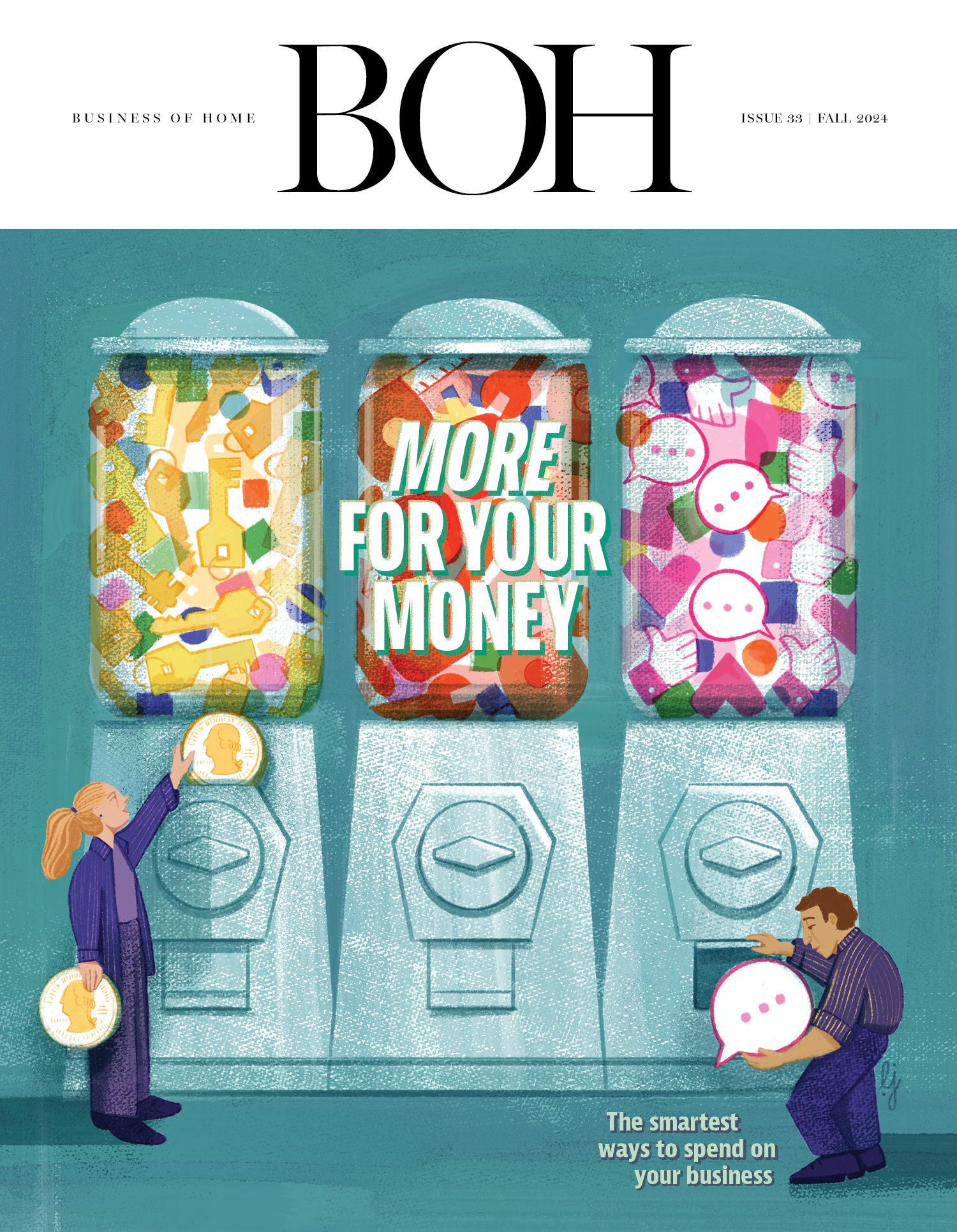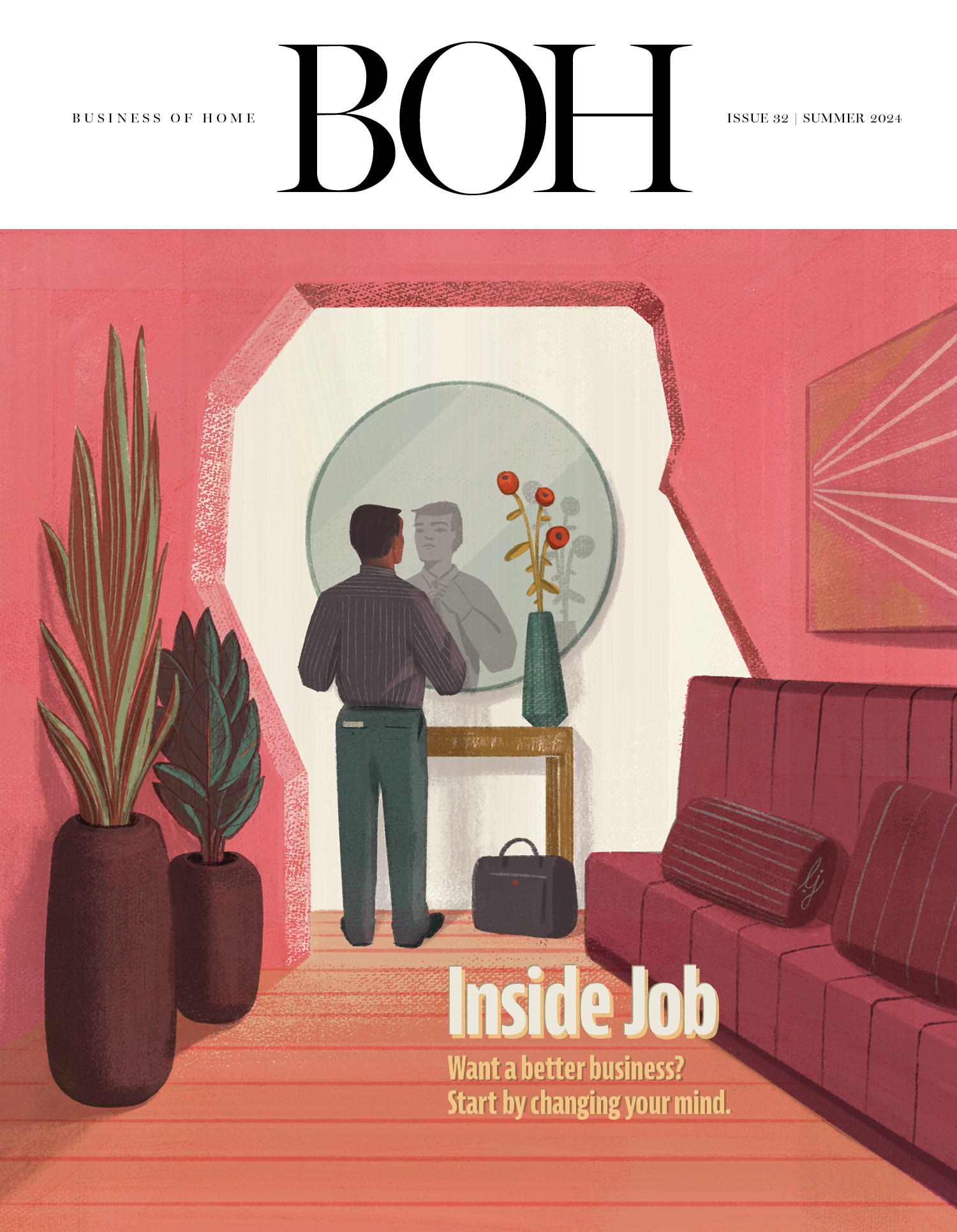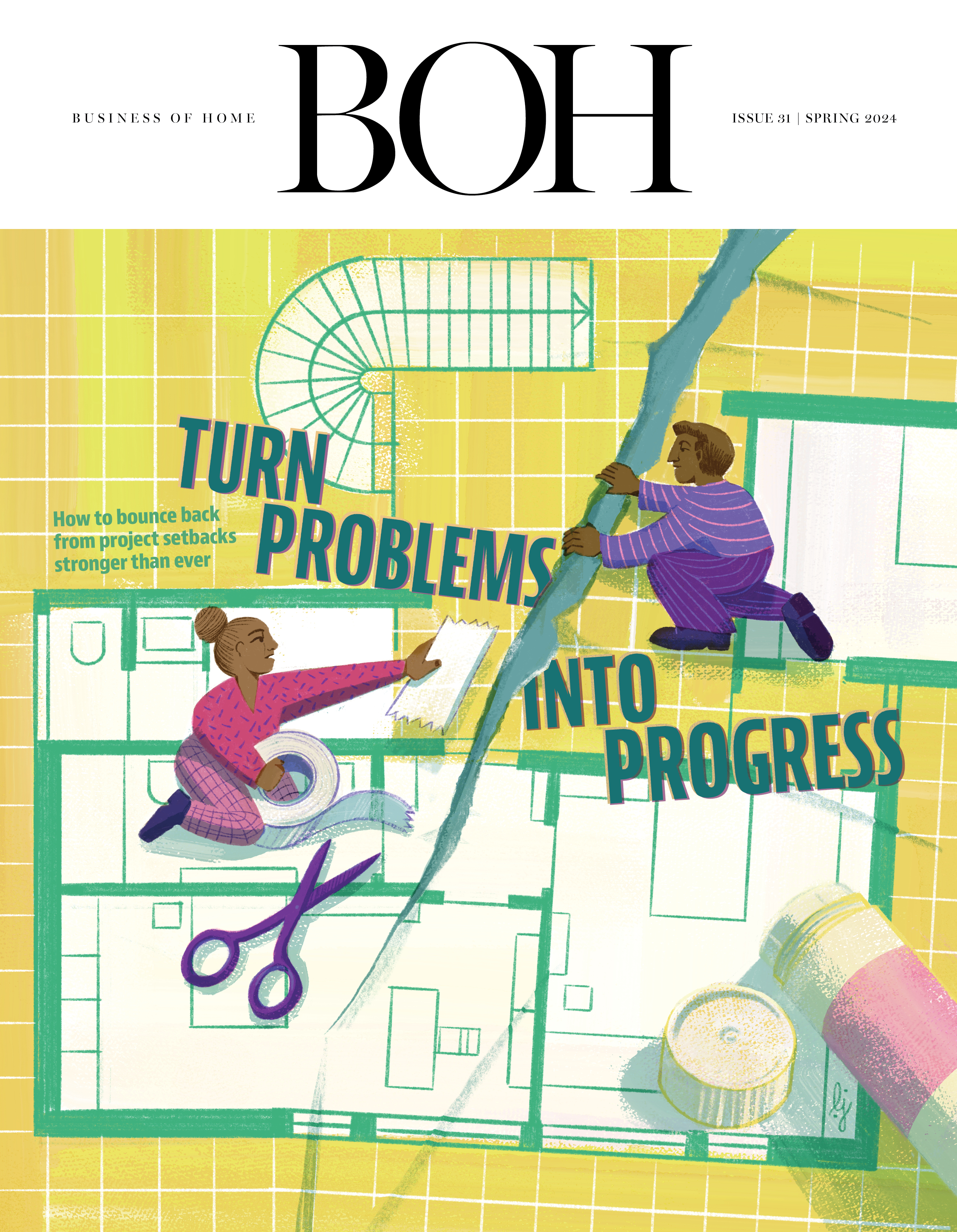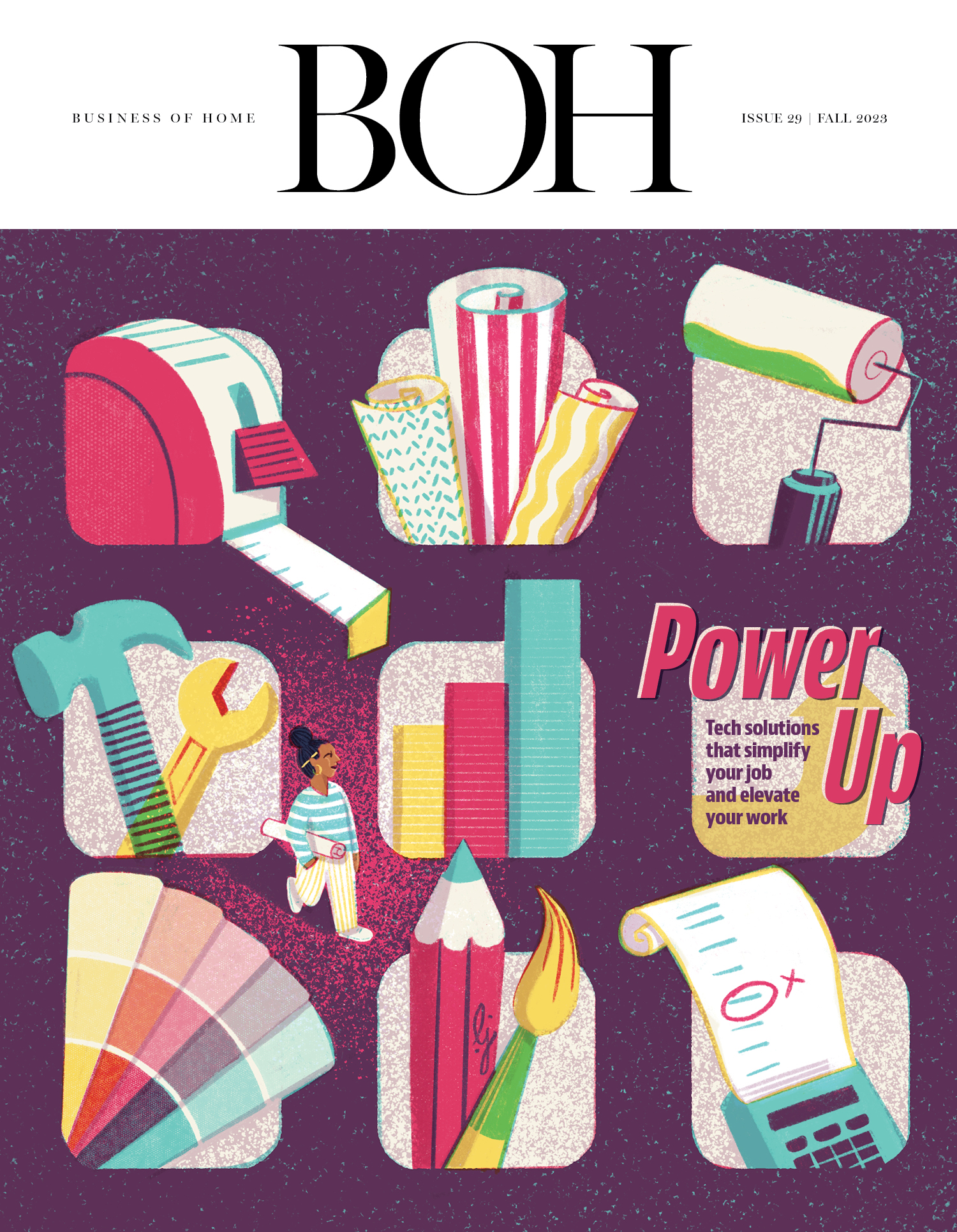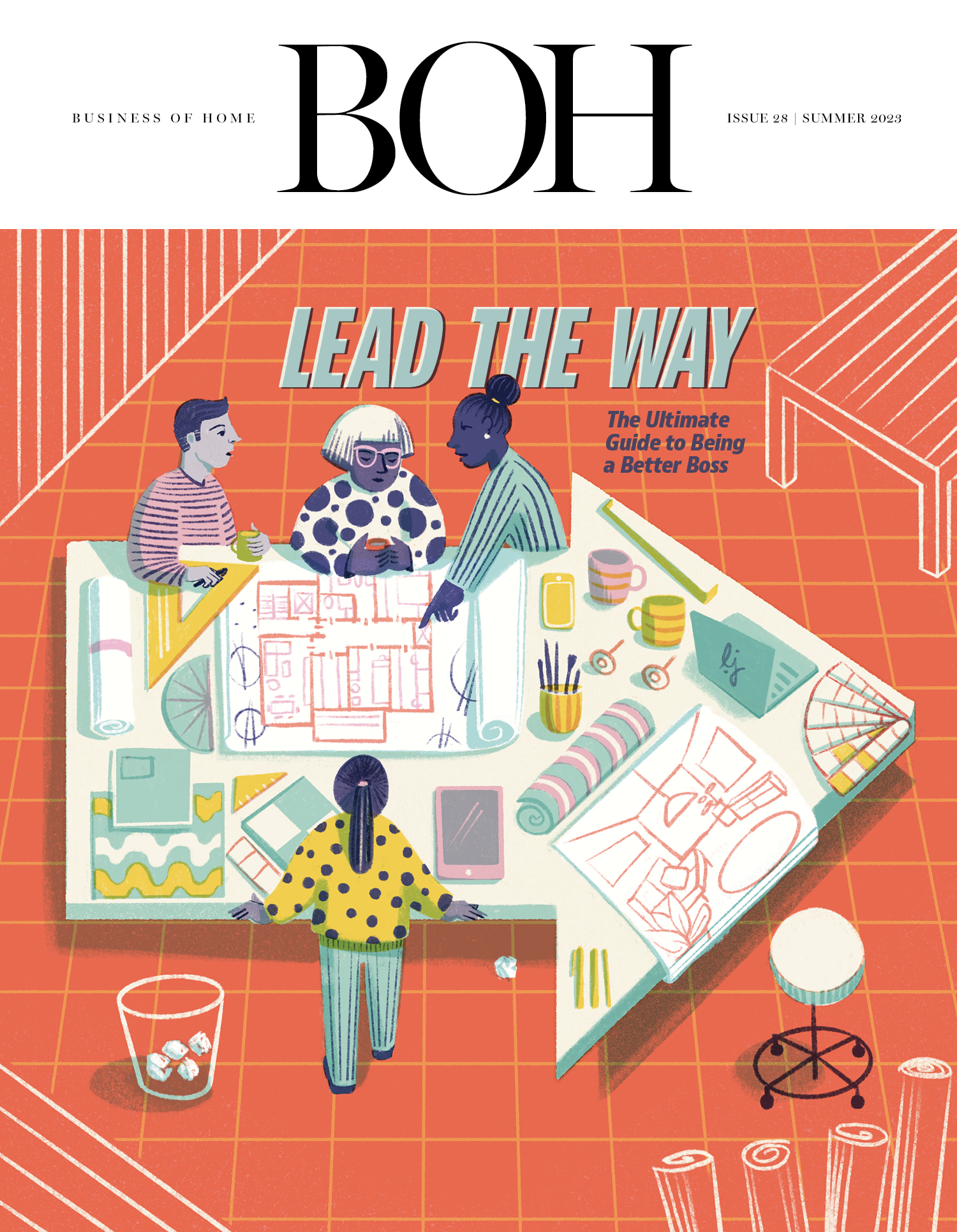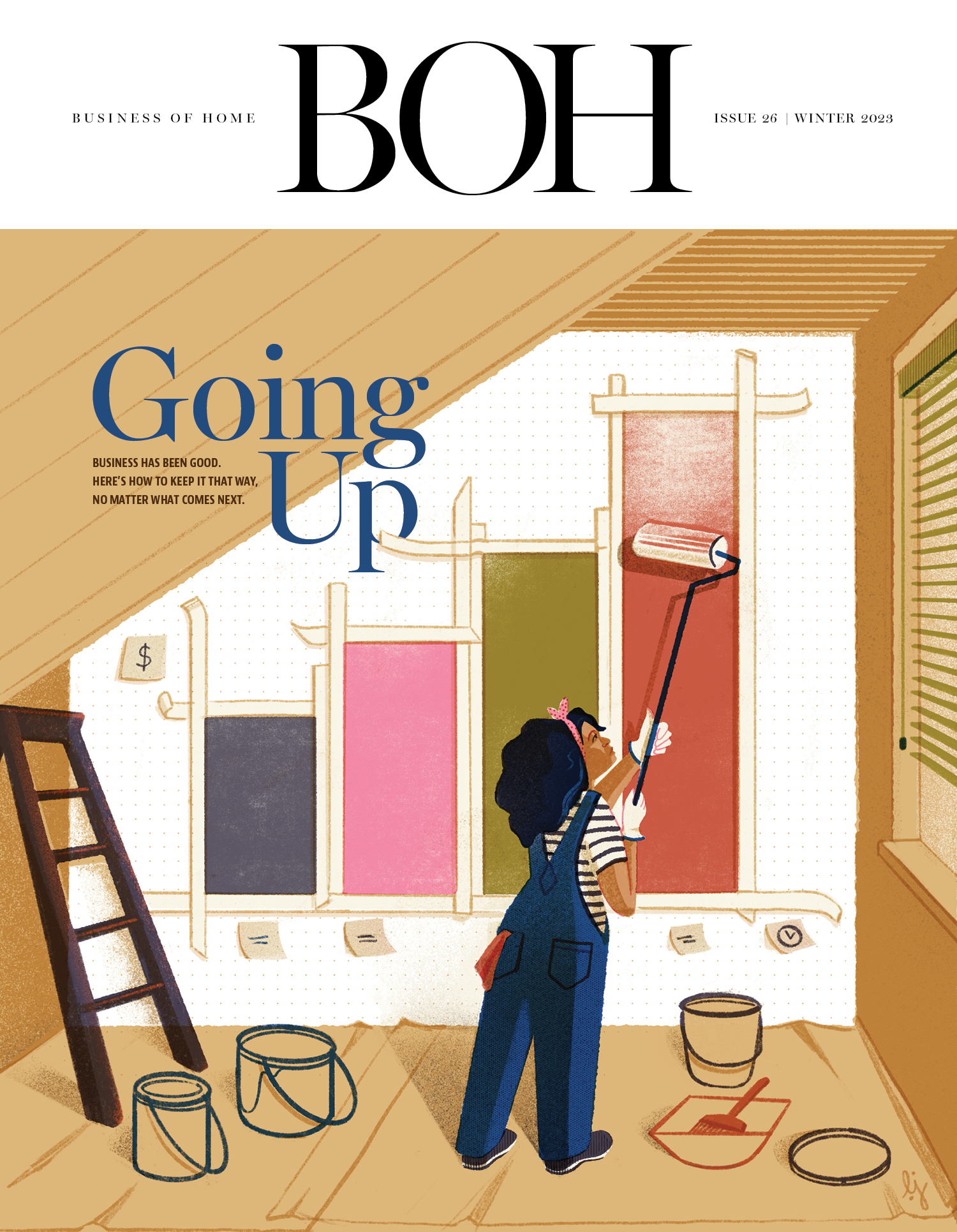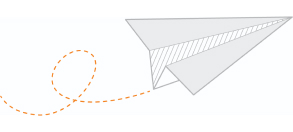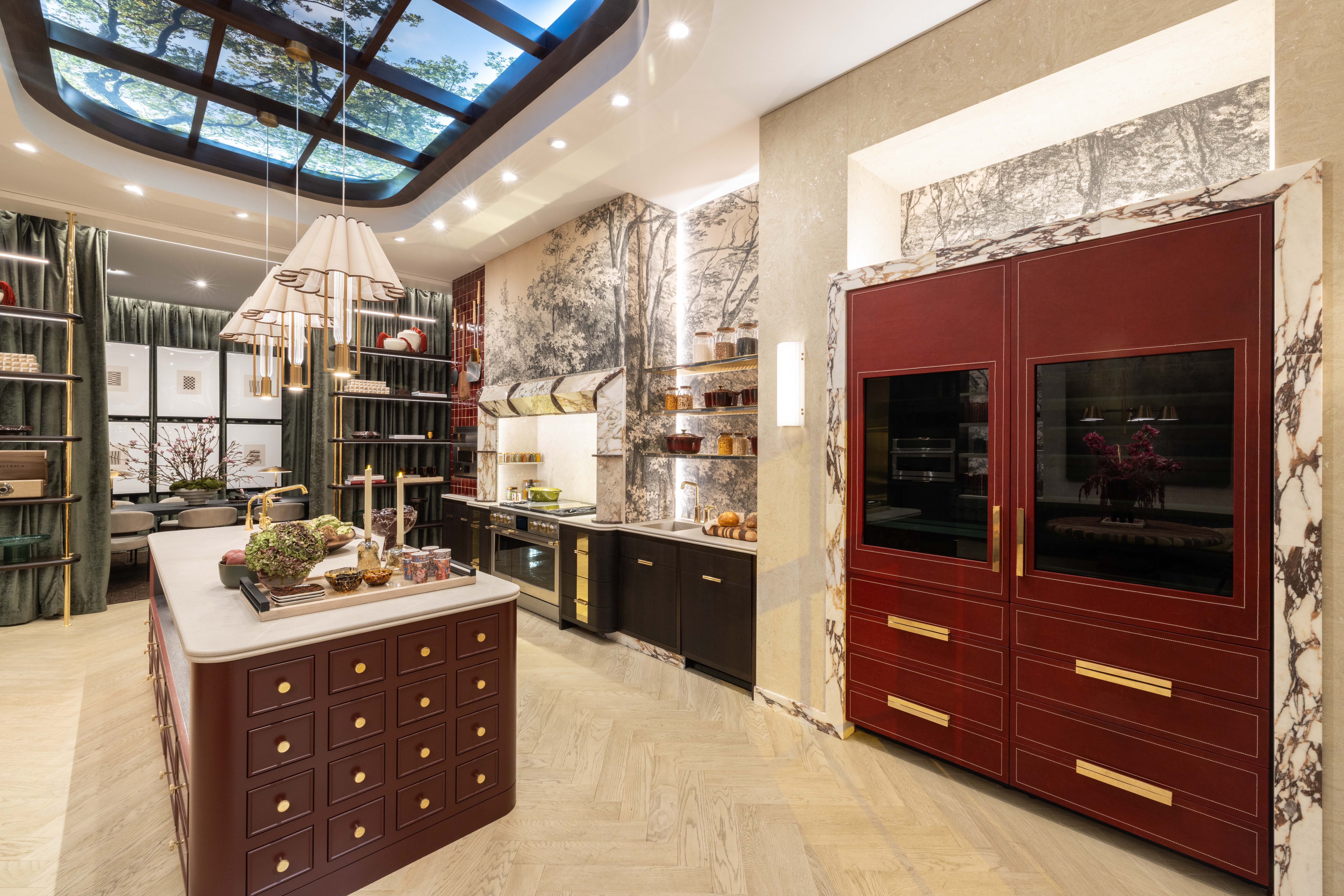Designers and manufacturers flocked to Las Vegas last week for the Kitchen & Bath Industry Show, where the nearly 700 exhibitors also seemed to take note of the organization’s increased focus on the interior designer audience. While the event is always a key source for specification, inspiration was also around every corner this year—found in over-the-top booth displays and detailed vignettes, many of which were created with the help of interior designers. Their work helped to highlight the innovations that took center stage at the show, including state-of-the-art home spa features, materials and appliances that promote “clean” cooking, and AI enhancements designed to help with everyday functionality.
BOH was on the ground at KBIS 2025—here’s what we saw.
Health and Wellness
A focus on well-being through design took on many interpretations at the show this year. Amid countless booths with over-the-top aquatic features (Kohler’s 10-foot waterfall and House of Rohl’s triple-stacked bathtub fountain were standouts), several exhibitors showcased technology and fixtures geared toward producing cleaner drinking water—achieved through filtration systems meant to get rid of contaminants like lead, chlorine, PFAS, pesticides and microplastics.
Other brands focused on cleansing the air: JennAir’s new induction stovetop comes with a powerful downdraft system that sucks away smoke and particles before they have a chance to drift up toward the user. The brand also emphasized the design possibilities: Without a hood or ducts, it allows for a floating island with no blocked sightlines. (Brands like Fotile and BlueStar delivered their own powerful filtration systems.)
Several countertop manufacturers boasted new lines with low-silica content, referring to the composite material used in artificial stone that’s known to cause often fatal occupational illness in workers. In that arena, Cosentino debuted Q0: a zero-silica surface material made from up to 90 percent recycled content, set to debut this summer.
Other innovations leaned into a more indulgent take on well-being. The cold plunge (which seemed to be this year’s of-the-moment wellness offering) was a major draw, specifically Kohler’s sleek new ice bath, created in partnership with New York and Los Angeles members-only social club Remedy Place. It ended up taking home the Gold for Wellness Trailblazer at the Best of KBIS awards.
Designer Touch Points
For the whole-home designer attendee, this year’s event was packed with industry peers. At the KBIS NEXT Stage, interior designers John McClain and Breegan Jane and design journalist Sophie Donelson hosted talks on topics ranging from client management to zero-waste design. Later on, the NKBA Design Council took the stage for a panel discussion on their career journeys and design practices. The inaugural roster of top designers—including Thom Filicia, Caleb Anderson, Michel Smith Boyd and Celerie Kemble—were appointed last year and have returned to spot trends and document their findings on social media.
On the showroom floor, several booths hosted pop-up talks: designers Jake Arnold and Ken Fulk presented at Kohler’s outpost, while Julee Ireland and Rydhima Shah Brar sat down for a discussion in the Fabuwood booth flanked by vignettes they’d each designed. For the event’s keynote session, Interior Design editor in chief Cindy Allen spoke with designer and architect Lauren Rottet.
Elsewhere, companies from other corners of the industry found opportunities for category expansion. Artistic Tile’s booth featured a new collaboration with Donghia—bringing some of the heritage brand’s iconic patterns to life in a large-scale mosaic—while Danver’s booth included a collaboration with Sunbrella, featuring a curated palette of colors allowing homeowners to coordinate their outdoor kitchens, furniture and accessories. Others made new efforts to court designers, such as Italian kitchen appliance brand Bertazzoni rolling out its new Virtuoso trade program, which allows certified architects and designers to earn rewards on appliances they specify for clients.
Some brands embraced the opportunity to showcase their products in vignettes that extended past the typical kitchen and bath spaces. With design direction from Kerrie Kelly, Fabuwood explored “breadth and versatility beyond the kitchen,” tapping Ireland and Brar to style an office, a laundry room, a media console area and a “party barn” in its booth. Kitchens are increasingly becoming multipurpose rooms—used as hosting and living spaces as much as for actual cooking—and the event’s leadership expects the trend to continue.
“If you’re a whole-home designer and the kitchen is becoming more and more influential, then you’re crossing into that kitchen design part—and the kitchen-design-focused people are also crossing into the living room, dining room and other spaces,” says National Kitchen & Bath Association CEO Bill Darcy. “We see the whole-home interior coming together more.”
Smart Tech
AI was a reliable buzzword at KBIS this year, and brands found plenty of reasons to apply the emerging tech to their appliances. There was Signature Kitchen Suite’s wall oven outfitted with Gourmet AI, which automatically identifies the food inside and suggests related recipes, along with allowing users to snap pictures of their food, record time-lapse cooking videos, and share the content online. GE’s new coffee maker includes the SmartHQ AI Coffee Assistant, allowing users to converse with the appliance for brewing tips and customization.
Meanwhile, in a freestanding booth situated away from the hubbub of the trade show floor, representatives from Collov AI allowed attendees to test out the brand’s virtual staging software. A little more than a year after the company’s $10 million Series A funding round, it has unveiled a further developed edition of its AI Cabinet design tool, allowing manufacturers to upload their brand’s wallcoverings, floors, cabinets and countertops to the feature, helping prospective customers visualize the products in real photos of their space.
One of the show’s biggest innovation scene-stealers, however, had nothing to do with AI. Tech company FreePower offers wireless countertop charging technology that can be embedded into the stone itself—which was on full display at KBIS in collaboration with Cosentino and James Martin Vanities. Attendees were able to try the tech out by simply placing phones on a designated spot on the counter. Before long—no plugs or wires required—they were charged.
Relationship Building
As Darcy tells it, the uniqueness of KBIS is its ability to serve as a source for specification, compared to other trade shows that focus more on inspiration and programming. But in recent years, with booths increasingly one-upping each other to deliver experiential environments, KBIS is starting to encroach on that territory. To a designer who may have attended a decade ago, he says, the event today would seem completely different.
“If you go back 20 years ago, KBIS was more, rows of faucets and rows of appliances. But we’ve kept up with the evolution of business and home,” says Darcy. In recent years, that’s changed dramatically, as exhibitors have paid far closer attention to creating a more designer-friendly atmosphere through their booth designs and offerings. Along with providing an environment for finding inspiration, he sees the benefit of KBIS attendance as providing a space for designers to interact directly with manufacturers.
“As a manufacturer, there was a lot of value for us to connect with the designers, because they can say, ‘Here are the issues we’re running into with our customers, and how can you solve for that?’” says NKBA senior director of marketing Heather Shannon, who formerly worked for brands like commercial refrigeration manufacturer Perlick Corporation.
NKBA bolsters these connections by hosting a number of smaller events and programming at localized chapters throughout the year. Last fall the organization hosted the first-ever NKBA | KBIS Design Experience at High Point Market, which included educational programming, culinary demonstrations, curated product displays and panel discussions. Last month, they launched the Kitchen & Bath Pro Hub, a digital research platform for design professionals. As for designers, attendance at the big event can be the moment that opens the door to a broader relationship with industry partners.
“You come to KBIS and you meet these people. You become a member, and you’re exposed to them at multiple events. They then become friends, they then become partners—and from a design perspective and a manufacturing perspective, you then have your go-to [people], your partners who you can be with throughout the year,” says Shannon. “It’s an ongoing, relationship-building partnership.”




